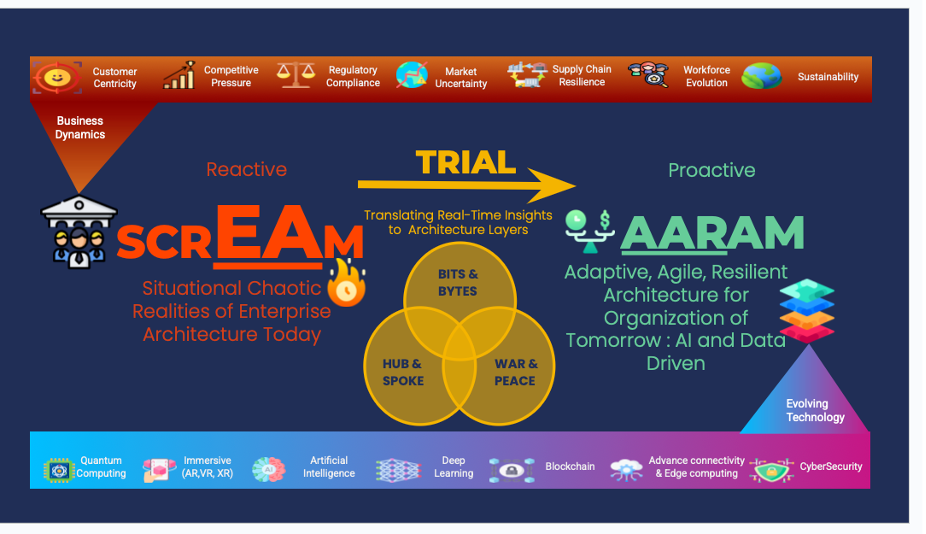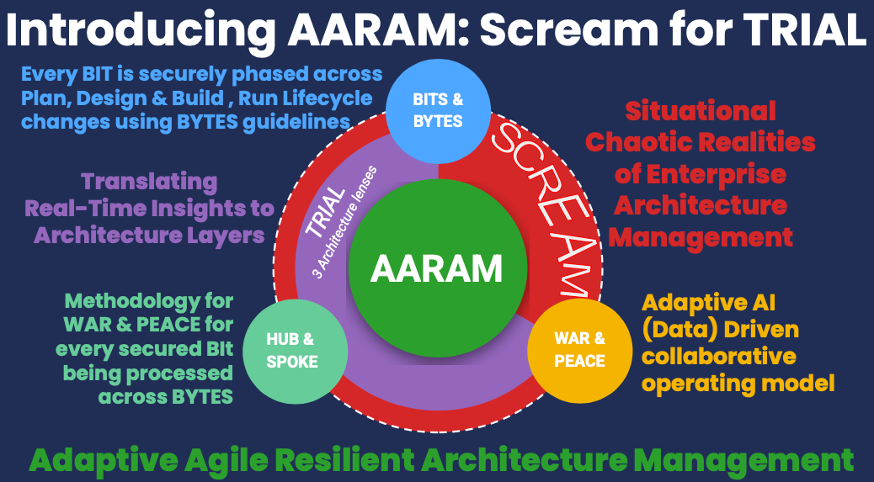
In an era where every discussion, whether personal or organizational, is steeped in the pervasive influence of AI and data, one naturally questions the true state of Enterprise Architecture (EA) within most organizations today. Too often, we observe situational chaos and a predominantly reactive posture, where EA teams find themselves supporting hasty executive decisions in a culture of order-taking. Businesses, in turn, perceive Information Technology as slow to deliver, while IT teams, grappling with a perceived lack of business understanding, struggle to demonstrate timely value. This dynamic often leads to organizations becoming vendor-driven, with core architectural management often unaddressed.
Despite this, there’s no doubt that the demand for Enterprise Architecture is surging. However, the existing challenges—from the sheer breadth of required skillsets and knowledge to the overwhelming abundance of frameworks to choose from—frequently plunge EA practices into moments of SCREAM: Situational Chaotic Realities of Enterprise Architecture Management.
However, among these challenges, there persists a profound desire for adaptive design and resilient enterprise architecture. Significant architectural efforts are indeed undertaken across organizations of all sizes. The equilibrium that every organization truly needs, however, often feels elusive. The critical question then becomes: How do we navigate this complexity? What are the realistic, practical ways to achieve that desired state? This is precisely the focus of this article.
The answer is not a call for yet another new framework. Instead, what we urgently need is a way to distill the key, inherent components of existing frameworks and knowledge into something actionable. Something that will not only empower practitioners but fundamentally enable organizations to transition from these moments of SCREAM to AARAM: Agentic AI Reinforced Architecture Maturities, the state of organizational equilibrium every enterprise craves.
What we need is TRIAL: Translating Real-time Insights to Architecture Layers. TRIAL embodies three essential lenses for architecture practice that allow organizations to:
- Sense and Respond: To dynamic shifts, whether driven by AI today, quantum computing tomorrow, immersive experiences, or other emergent technologies, ensuring the architecture remains balanced and leverages these advancements based on the evolving business construct.
- Leverage Data: Continuously understand and evolve the organizational architecture across its different domains, adapting with every transformation that is underway.

Figure 1: Illustration of SCREAM leading to the need for TRIAL.
TRIAL: Translating Realtime Insights to Architecture Layers
When an organization finds itself amidst the SCREAM—the Situational Chaotic Realities of Enterprise Architecture Management—the key lies in having a systematic approach to cut through the noise and act effectively. This is precisely the role of TRIAL: Translating Real-time Insights to Architecture Layers.
TRIAL is designed not as a new, standalone framework to add to the existing heap, but rather as a meta-approach—a powerful lens—to simplify, integrate, and operationalize existing knowledge in the age of data and AI. It provides architects with a practical, simple, easy to understand guide to ground architectural endeavors in tangible reality, ensuring strategic vision translates into achievable and impactful designs without demanding exhaustive new learning. TRIAL leverages what architects already know, providing clarity and direction amidst the abundance.
This component operates through three distinct, yet interconnected, lenses, each functioning as a pragmatic algorithm or systematic approach to architectural problem-solving:
- Bits & Bytes (The foundation): a foundation lens designed to provide a universal language understanding and managing organizational architecture. BITS as the core architectural domains and BYTES as the guiding principles. By establishing this clear paradigm, Bits & Bytes ensures balanced, contextual management of every architectural detail across all life-cycle phases, making complex concepts accessible to every stakeholder and driving effective, outcome-driven transformation
- War & Peace (The Organizational Harmony) : Recognizing that architecture is as much about people as it is about technology, this lens addresses the critical element of organizational engagement and alignment by fostering a collaborative environment where architecture initiatives gain widespread buy-in during architecture component life-cycle changes. It helps architects leverage data and AI to build consensus, moving from internal friction to organizational fluidity.
- Hub & Spoke (The Mechanism): This lens defines a potent methodology distinct from traditional integration patterns, designed to be the operational linchpin of the transformational maturities. Hub & Spoke paves the way for a future where AI, not manual effort, fundamentally shapes and guides enterprise architecture, ushering in an era of unparalleled efficiency and control.

Figure 2: Overall representation of the approach.
By applying the TRIAL lenses when facing SCREAM, organizations gain the clarity and actionable insights necessary to navigate their complex landscapes, leveraging their existing knowledge base more effectively.
As an architect, Rajeev Prashar excels at bridging the critical gap between complex business requirements and technical realities. He is a collaborative leader who works with stakeholders at all levels to develop strategic architectural roadmaps and influence successful execution. He believes that effective enterprise architecture is not just about technology, but about empowering organizations to achieve their strategic goals.
The viewpoint is solely his and not associated with any of the companies he has worked with.
